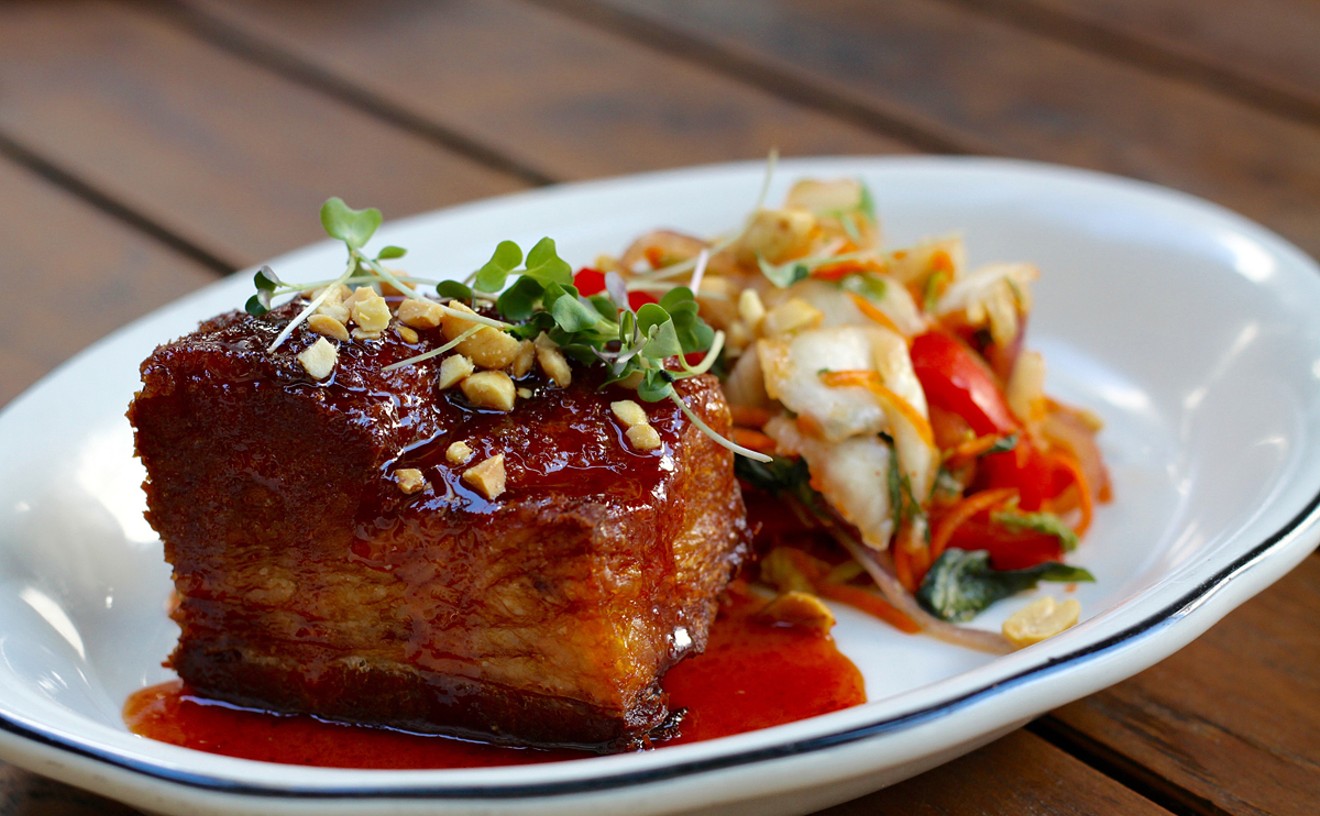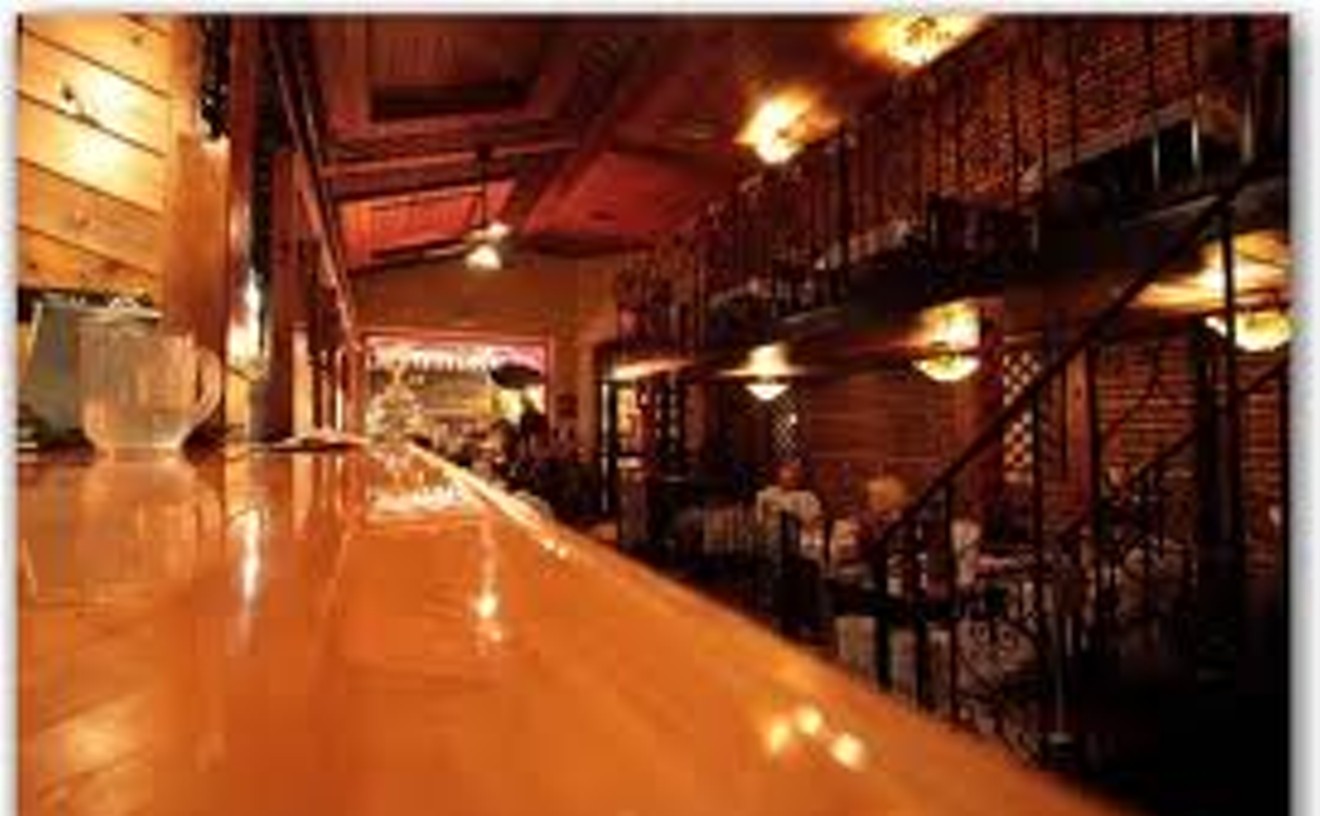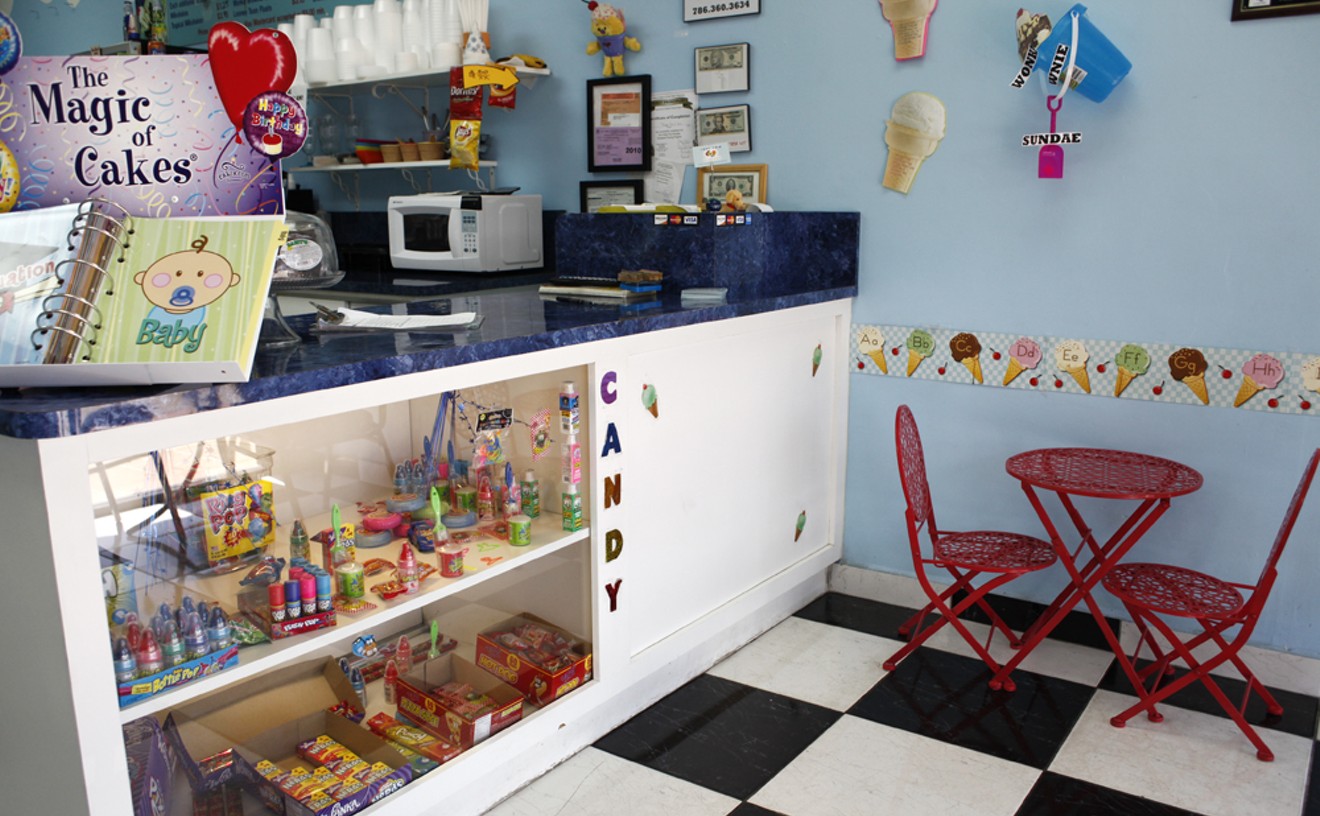
Photo courtesy of Genuine Hospitality Group
"It sells pretty good," says Todd Webster, the man who butchers much of the meat at Michael's Genuine Food & Drink. "We braise them for about four to six hours, cut them into thin pieces, and fry them until they're nice and crispy on the outside." "They're a pretty popular bar snack," echoes Travis Starwalt, sous chef at Sugarcane Raw Bar Grill. We braise them... slice them thin, dust them in flour, fry them, and toss them in our house-made barbecue spice." Michael's began serving them about a year ago, offering the crunchy bites as a snack seasoned with spice mix ($6) or atop an arugula salad with shaved radish and red onion, dressed in sweet lime vinaigrette ($8). Sugarcane offers them with a wedge of lemon ($4). "People will order one, and then they'll order another one. It's perfect for people hanging out at the bar and having a beer or cocktail," Travis concludes, and at this point we're all ears.
- 130 NE 40th St., Miami, 33137 Map
- 305-573-5550
- michaelsgenuine.com
Best New York Switcheroo
Quattro Gastronomia Italiana

It was August 2006 when chefs Nicola and Fabrizio Carro, identical twins from the Piedmont region, introduced their exquisite Northern Italian fare at Quattro in Miami Beach. One can never have too many chefs imported from Italy. On the other hand, a saturation point exists for restaurants imported from New York — especially when said restaurant's big-name chef lets his name do more work here than his body. More to the point: The Manhattan-to-Miami restaurant exchange has been one-sided for too long. So when our own hometown Quattro opened a sister establishment in New York (in the Trump SoHo no less!), it made a statement of sorts: Miami's dining scene is growing up fast, and it might not be fitting into the Big Apple's hand-me-downs for long.
- 1014 Lincoln Rd., Miami Beach, 33139 Map
- 305-531-4833
- www.quattromiami.com
Best Gelato
Dolci Peccati truck

Alex Broadwell
Dolci Peccati bills itself as the "sweetest truck on the road," and that's true in every sense of the word. Not only was it one of the first all-dessert trucks to hit the road in Miami, but also its 20-something twin co-owners are among the friendliest mobile proprietors around. The Yepes sisters are all smiles in Hello Kitty aprons as they serve small but satisfying portions of the creamy gelato they make in modest batches every day. Every flavor is creamy and dense, as gelato should be, with the underlying boldness of component ingredients. Mint-chocolate chip, for instance, explodes with spearmint flavor, while cookies and cream melts with a rich vanilla finish. Of course, there are all the usual gelato flavors, such as pistachio and hazelnut, but the sisters whip up new combinations, like chocolate-blood orange, to mark special occasions or simple changes in whimsy. Meanwhile, their signature garnish is a special sweet-savory balsamic sauce most popular over strawberry and other fruit flavors.A small, approximately three-quarter-cup serving ($3) packs a lot of flavor, so it's almost guilt-free, although a large ($4.50) won't set you up to go for caloric broke either. Larger take-out containers are available for $8 and up, but you'll want to hurry home with those — the frozen goodness, like so many other amazing things in life, doesn't hold up well over time.
- 274 NE 59th St., Miami, 33137 Map
- 954-632-8551
- dolcipeccatigelato.com
Best Fried Chicken
Fritay Fried Pork & Chicken

Inside a cozy storefront on NW Seventh Avenue in North Miami, the fryers are snapping, crackling, and popping Monday through Saturday from 11 a.m. to 10 p.m. The family-owned Haitian restaurant serves deliciously sinful wings, drumsticks, and breasts that are fried to crisp perfection. The meat is juicy and tender every time, whether you request a $2.49 two-piece meal or a ten-piece family feast for $7.99. Every meal comes with sides of small rice, acras — fritters — and sweet plantains or fries. Fritay has been providing dine-in and take-out to North Miami's Haitian community since 2008. The restaurant is also big on community service, awarding a $6,000 scholarship to a minority student from the community every year. Fritay is conveniently located off I-95, just a few blocks from the NW 125th Street exit.
- 12143 NW 7th Ave., Miami, 33168 Map
- 786-866-9674
- www.fritayrestaurant.com
Best Key Lime Pie
Fireman Derek's World-Famous Pies
When he's not cooking meals for the guys at Miami Fire-Rescue Station 1, Derek Kaplan is baking pies: apple, coconut cream, peach, banana cream, pecan, chocolate pecan, and his signature key lime. It all started as an experiment to perfect his recipe, but friends liked what they tasted, and Fireman Derek's Key Lime Pies was born in 2008. The citrusy dessert has just the right balance of tartness and sweetness. Its filling, prepared with fresh-squeezed key lime juice, is creamy and delicious, and the graham cracker crust is homemade. Pies are available whole ($15) or in single-serving cups ($3 each or ten for $25), which are the perfect size to indulge with less guilt. Find them around town at places such as La Camaronera, Slice-N-Ice, and Bon Appétit Walk-A-Way Café (2600 NE Second Ave., Miami), where Kaplan bakes his wonders. Or simply call or email him to order.
Best Cupcakes
2 Girls and a Cupcake
Got a secret fetish for sugar porn? There's no shame in getting off on sweet, moist treats. And 2 Girls and a Cupcake knows how to bring orgasmic bliss with aphrodisiacs such as Kiss Me I'm Cuban, a tropical coconut cupcake topped with mango buttercream and toasted coconut. Then there's the Ocean Drive, a blue vanilla cupcake topped with yellow buttercream and dusted with brown sugar. The 20-something-year-old bakers behind 2 Girls — Evelyn Dieppa and Lorena Castro — are always adding a sexy Miami swagger to their fluffy, sinful treasures. When the sisters competed on Food Network's Cupcake Wars earlier this year, they paid tribute to local hip-hop luminaries such as Pitbull and Mayday by creating Mr. 305 — a vanilla cupcake with mango filling and vanilla buttercream — as well as Stuck on a Cupcake, a vanilla-peanut butter chip version with grape jelly that's topped with peanut buttercream. Dieppa and Castro didn't win the show's $10,000 prize, but their cupcake operation, which launched on Valentine's Day 2008, is flourishing. The pair's online bakery features every single flavor available, including a special menu of alcohol-infused cupcakes for kiddie-themed adult parties. Prices range from $1 to $3 per cupcake.
Best Desserts
Sosta
Dessert menus at pizzerias are usually predictable and snore-worthy, so the folks at Sosta are probably damn happy that award-winning pastry chef Antonio Bachour is in charge of theirs. Let the competition serve stale cannoli from the neighborhood bakery, slightly defrosted cheesecake from a big-box store, and icky spumoni with candied cherry chunks. We'll be digging into Bachour's creamy vanilla panna cotta, decadent torta di cioccolato with pistachio gelato, and tiramisu made with Gianduja, sweet chocolate with hazelnut paste. Speaking of which, don't even get us started on the eight-inch Nutella pizza pie. Pizza dough spread with chocolate and dusted with powdered sugar? OMG. Bachour can always be counted on to come up with confection wizardry, wowing with prismatic color combinations and meal-enders that are never too sweet or too savory. La dolce vita, indeed.
Best Churros
Manolo

The first restaurant of Manuel Benito and his family debuted in Burgos, Spain, in 1930. The clan immigrated to Uruguay during the Franco days, and Manolo became their trademark name for eateries in Costa Rica, Peru, Panama, Argentina, and the good old USA. Churros have a longer history than that. The fried, fluted, sugar-sprinkled sticks are said to be named after the churro, a breed of Spanish sheep, and first made by shepherds centuries ago. Then again, Sephardic Jews and Arab Moors each arrived in Spain with sweet, fried-batter treats, so it's possible one of those groups can take credit (let them fight it out). We do know that churros spread from Spain to Central and South America, and that Manolo serves them the same way as churrerías in those places: either plain (55 cents each) or churros rellenos, meaning filled with chocolate, vanilla custard, or dulce de leche (75 cents). It's a cheap thrill.
- 7300 Collins Ave., Miami Beach, 33139 Map
- 305-868-4381
Best Dessert Crêpes
Otentic

Photo by John Zur
The history of the crêpe is fodder for debate. Some contend the name is French for "pancake" and thus conclude the person who prepared the first flapjack in France simply forgot to add baking powder. This theory is vigorously disputed by the Crespelle Conspiracists, who believe the crêpe recipe was stolen from Italy by French nationalists in retaliation for Pope Clement VII's actions against Charles V in 1526. Who knew? One thing not debatable is that the owners of Otentic Restaurant prepare the sort of authentically delectable dessert crêpes one might find proffered by a Parisian street vendor. For $6.50 each, the ethereal circles are delicately filled with choice of ice cream, banana, strawberries, chocolate mousse, honey, sugar, jam, Chantilly cream, or, our favorite, the classic Nutella chocolate-hazelnut spread. The French chef pours the batter on a specialized turntable-shaped griddle, waits for those caramel-colored dots to appear, flips the crêpe, slathers on the sweetness, folds it, and delivers it still steaming to the table. Otentic likewise spins savory crêpes ($7 to $8) for patrons with less of a sweet outlook on life.
- 538 Washington Ave., Miami Beach, 33139 Map
- 305-531-1464
- otenticrestaurant.com
Best Ice-Cream Parlor
Todo Frio

Leah Gabriel
Forget checking Yelp to find the latest fancy, overpriced yogurt shop. Sure, that spot has a cutesy name, Ikea décor, UM girls who think your facial scruff is way cool, and other temptations such as 1,000 self-serve toppings charged by weight. Keep it simple and opt for ice cream. Todo Frio does it old-school with good, traditional, calorie-laden, scooped-up, no-soy-substitutes frosty stuff. The sweetest part: old-timey prices. An ice-cream cone will set you back $1.50. Flavors include tropical mango, coconut, pineapple, conventional vanilla and chocolate, and even hyperactive-kindergartener-tamer Spider-Man, AKA vanilla with food coloring. Mostly, though, it's a nice throwback to yesteryear — neither too shiny nor too perfect. You can stop here when you're not in the mood for the barely legal set swooning about the latest RPattz movie and his Us Weekly cover.
- 2715 SW 37th Ave., Coconut Grove, 33133 Map
- 305-442-1907
- www.todofrio.net





